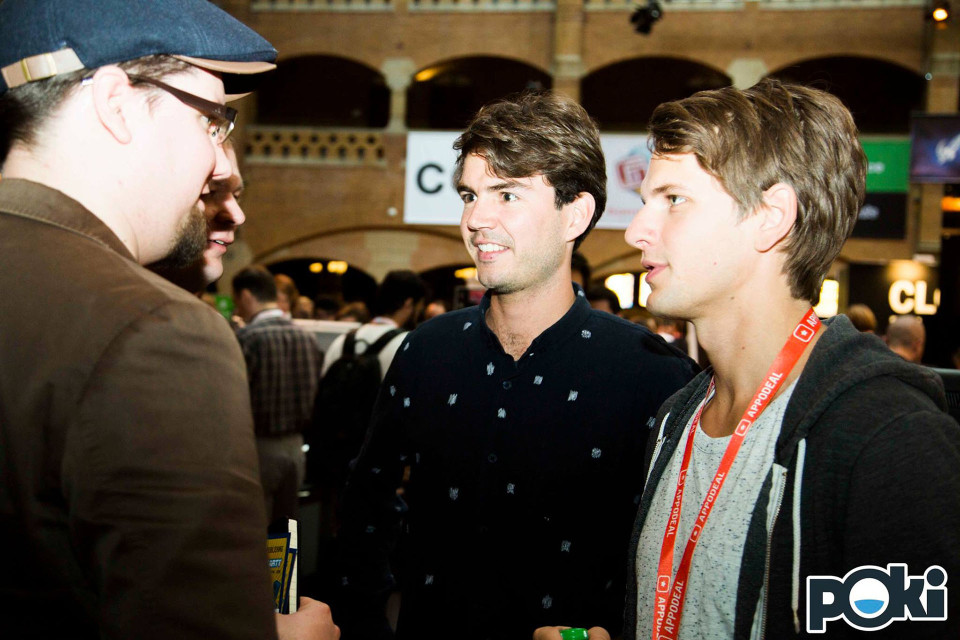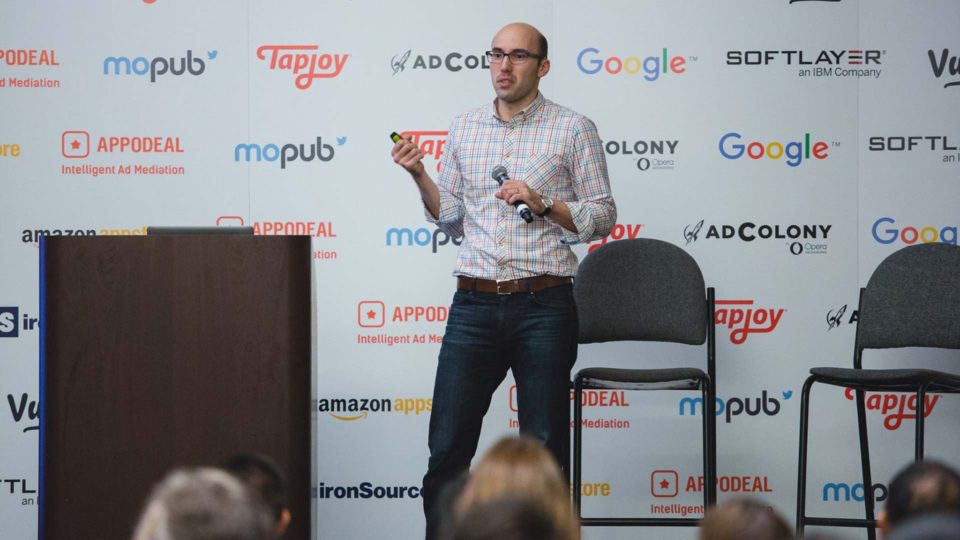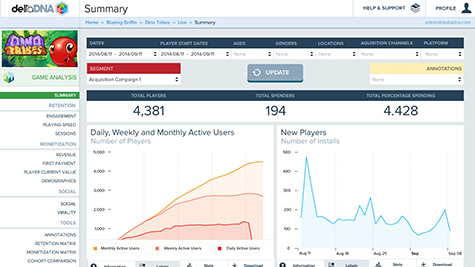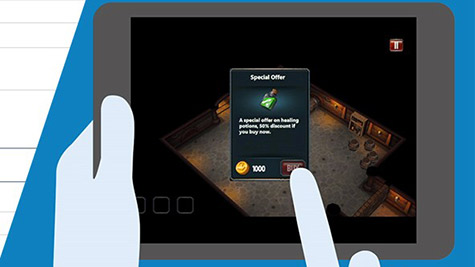Video ads are quickly becoming the advertising industry’s new mainstay. Gone are the days of static placements and banner ads. At Casual Connect USA 2016, MoPub’s group product manager, Boris Logvinskiy, explained why video has become such an important advertising format during his lecture Rewarded Video: Optimize Your Strategy.
main
BusinessDevelopmentExclusive InterviewsGame DevelopmentIndieIndustry
Shelley LK: Gaming the Top Talent in the World
Online platforms make launching a game to a worldwide audience easier than ever. It’s also possible now for a developer to come from any country and make a game that makes a huge splash in every region. With this in mind, IPC Ventures has launched their Gaming Top Talent competition, designed to draw in the best young developers of online mobile games. The first batch of submissions will conclude on April 20, 2016.
Gamesauce spoke with Shelley LK, managing partner at IPC Ventures, during the post-GDC period and talked at length about the importance of industry events, challenges within the mobile industry, and how young developers will approach Gaming Top Talent, from application to the finale.
BusinessContributions
Poki Publishing: Helping Game Developers to Create Success

Working in a smart, iterative way has helped Poki to offer a great user experience to their global audience in 50+ markets. The company in its current form was founded in 2014, works with a team of 30 and goes on a yearly company retreat to a tropical island in January. They are now opening their way of working to game developers.

BusinessContributions
7 Hacks for Better Mobile Game Monetization
As a mobile game developer, you want to create the best game possible. You have most likely thought long and hard about gameplay and story — two of the most important aspects of a successful game. And the established story likely influenced the art style you chose to fit the world you are creating.
Often forgotten at the development stage, but equally important, is to consider the best way to generate revenue from your hard work. The mobile game market is crowded to say the least, and that’s why effective monetization is so essential for success. Games represent almost 22% of the total number of apps in the Apple Store — every month more than 12,000 new games are submitted. The mobile games revenue global market is also estimated to reach 30 billion USD this year, representing 30% of the total games market. Despite the competition, revenue generated from mobile games lead when looking at app revenue.
BusinessExclusive InterviewsIndustryOnline
Mark Robinson: “Look Deeper” at Your Data

Mark Robinson likens the experience of data-mining to exploring a new city, noting “I have always liked being lost … and then uncovering something surprising and thought-provoking.”
Robinson has been tackling data analytics and helping bring companies closer to their customers for over 15 years. But one sector has been lagging in connecting with their user base. “The (gaming) industry lives with retention rates that are too low,” Robinson says. “And it’s our fault, not the players. By getting closer to the players, we can understand their frustrations and deliver fun more consistently.”
BusinessContributionsExclusive InterviewsIndustryOnline
Gamblit Brings Gaming and Gambling Together
Gamblit Gaming’s CMO David Chang spoke about how Gamblit connects gaming and gambling, as well as the trends in both the gaming and gambling industries that he’s witnessed over the last few years, with TechnologyAdvice host Clark Buckner. TechnologyAdvice.com provides coverage content on teaching and training games, strategic employee engagement software, and customer loyalty programs and much more. Also be sure to check out their gamification tech conference calendar.
BusinessExclusive InterviewsIndustryOnline
DeltaDNA CEO Mark Robinson on Current F2P Challenges
DeltaDNA was an early adopter, so to speak, of the Casual Connect conference, knowing that it would become a great environment to build relationships, grow their network, and both give and receive value from the innumerable conversations that occur before, during, and after the conference. In 2014, they were a proud Gold Sponsor of Casual Connect USA 2014. While there, DeltaDNA CEO Mark Robinson spoke about the concept of Player Relationship Management, how the industry has evolved in the free-to-play (F2P) space, and techniques DeltaDNA uses to increase engagement and create better gaming experiences with Clark Buckner from TechnologyAdvice.com (they provide coverage content on enterprise employee engagement, customer loyalty and rewards, and gamification trends and much more).
Responsive Games in the Free-to-Play Market

Launched in 2010, DeltaDNA uses a Player Relationship Management platform to maximize player engagement in free-to-play games. Using this platform, developers can interact with players within the game, collect rich data based on player experience, and use that data to craft a version of the game that’s more responsive to the player.
Through his work, Robinson identified three areas in which the F2P gaming industry has trouble:
- A lack of rich data on player behavior: By balancing game dynamics to satisfy average players, developers end up satisfying no one.
- A lack of retention: Less than 40 percent of F2P gamers typically come back to a game after an initial session.
- A lack of great, creative ideas: Game developers and publishers are always on the lookout for well-executed games.
So how does DeltaDNA address these challenges in the F2P space? First, they work to understand player behavior. Developers can interact with a specific player in their game so they are able to customize game mechanics according to a player’s style or competence, using a platform such as DeltaDNA‘s. Then, they make games more responsive. Better gaming experiences stem from responsive, user-driven, tailor-made game situations. And lastly, they use analytics in an effective manner. When designers or publishers work closely with an analytics team, they’re able to obtain rich data, such as direct feedback on retention rates or why some players leave a game sooner than others. They can then devise solutions to increase retention levels as well as to create player segments for better engagement and possible monetization strategies.

By leveraging real-time data and understanding player behaviors, DeltaDNA can design and create games that are more customized and responsive, thereby establishing long-term value, increased engagement, and a better end-user experience. Robinson added that they work to ensure that players have a great experience regardless of their competency or playing style. They don’t want the free-to-play model to be seen as an inferior gaming experience simply because it’s free.
Robinson also noted the necessity for a messaging strategy. Developers and publishers need to be consistent and intelligent in terms of their messaging without inundating users with too many messages. This can be done by fully understanding the different player characteristics in one’s game, as well as by considering how to manage player experiences in a way that their players will want to respond to messaging.

The Future of the Casual Gaming Industry
According to Robinson, the most exciting and successful companies in the gaming industry are starting to adopt new skill sets in order to get closer to their respective playing communities. Developers and publishers now have multi-scaled teams with new skills and a reliance on analytics. Additionally, marketing is now a more important part of the process alongside development, design, and creative.
For Robinson and DeltaDNA, the next step in the industry is realizing that a game developer/customer relationship won’t be limited to a one-game environment. Rather, they see multi-game relationships forming between publishers and gamers, thus creating more engagement for a publisher and more value for consumers.
For more information on DeltaDNA’s features, solutions, and resources, visit www.deltadna.com. To listen to the full interview, click the play button below:
BusinessContributionsExclusive InterviewsIndustryOnlinePR & Marketing
Millennial Media’s Lewis Rothkopf on Better Games through Big Data
Lewis Rothkopf, the senior vice president of global monetization solutions at Millennial Media, moderated a panel discussion on Leveraging Data to Build Better Games and Enhance Monetization at Casual Connect USA 2014. While there, he spoke about that panel, Millennial’s ongoing projects, and the current and possible future trends at the intersection of big data and gaming with Clark Buckner from TechnologyAdvice.com (they provide coverage content on enterprise employee engagement, customer loyalty and rewards, and gamification trends and much more).
Millennial Media is an independent audience platform in the digital advertising space that connects brands and consumers by leveraging data through a mobile-first approach and cross-screen targeting solutions. Rothkopf oversees the company’s publisher and developer relationships. Consequently, he has a unique understanding of the opportunities and difficulties facing today’s gaming industry.
Better Games through Data-driven Decisions
Part of his panel discussion at Casual Connect concerned itself with one of the gaming industry’s major challenges: developers and marketers need to tap into ways of leveraging data so they can make smarter, more efficient, data-driven decisions in order to reach the right consumers in the right place at the right time on the right device with the right mindset and within the right context.
Additionally, Rothkopf pointed out three other critical areas that need to be addressed:
- Actionable Intelligence: Developers need to gather deeper and less obvious insights based upon in-app behaviors. Such insights are observed alongside third-party data based on offline behaviors so that developers can make faster, smarter decisions in regards to monetization and user acquisition.
- Hyperlocal Targeting: Developers are tying everything back to local, both to monetize and acquire users. Such hyperlocal targeting that reaches consumers in the right place, mindset, and time can be a challenge.
- Individual SKU-ing: Developers are realizing that creating hits is very much a numbers game. Consequently, they’re releasing a much greater volume of individual SKUs and iterating on them once they’ve taken a foothold instead of hoping to release one monolithic, tent-pole title. Many casual titles are also being released in the hopes that one or more of them will hit it big (see Flappy Bird).
Acquiring Users and Monetizing
Rothkopf found that the Casual Connect audience wanted to know more about data conversion in terms of giving developers an edge in user acquisition and monetization—two areas that Rothkopf and his team at Millennial Media understand. He cited two specific areas that Millennial Media currently focuses on in order to help devs acquire users and work toward monetization: location and cross-device and cross-screen.
When focusing on location, Millennial Media marries location and context. In partnership with Esri, they’re re-launching Point: Audience Location Advertising, where their clients can target traditional location dimensions (country, date, etc.), time dimensions, and hyperlocal dimensions like household income, environment, propensity for shopping, etc. To deal with cross-device and cross-screen, Millennial Media also offers PATH, a mobile-first, cross-screen advertising suite that helps advertisers reach consumers anonymously. PATH provides access to tens of millions of cross-screen profiles in a seamless manner.
Successful Gaming Marketing
Finally, Rothkopf stressed that success comes from having a fair exchange of value, achieving relevant advertising, seeking the right targeting, and leveraging both first- and third-party data to make smarter decisions to drive monetization and deliver a better gaming experience.
To hear more from Lewis Rothkopf on big data, gaming, and his insights from Casual Connect USA 2014, listen to the podcast interview below. For more information on Millennial Media, visit www.millenialmedia.com, or if you’re a developer seeking to acquire users or working toward monetization, visit www.mmedia.com.
BusinessExclusive InterviewsIndustryOnlinePR & Marketing
Geoffrey Greenblatt in the New Frontier
Geoffrey Greenblatt, the North American gaming director for Mindshare, became interested in gaming at a very early age. He was four years old when his father brought home a Texas Instruments computer, and he was instantly hooked. Handheld games, Sega, Gameboy, Genesis and Super Nintendo all followed. He doesn’t claim that first computer was the inspiration for his career, but he says it was definitely the jumping off point of his interest in games.
Games and Advertising
His moment of inspiration actually came when he moved from traditional media to digital media. On his first day in that space, he saw an ad in a game, learned that it was served dynamically and thought, “Wow! Games and advertising. Now that’s an area I want to explore.”
After that moment, Greenblatt decided to dive in and see what could be done in the space. He began by putting together integration-based programs and proposing additional opportunities to clients who were interested in the gaming space. His breakthrough came with developing the first content distribution program on Xbox LIVE for Sprint. They were short-listed at Cannes, and interest grew from there. He considers himself fortunate to have had such supportive clients, but the biggest hurdle in getting the project off the ground was explaining how it could drive success for the brand.
This is still the biggest hurdle to overcome. Greenblatt recognizes that brands are not interested in the tactical details of a program; they are interested in how a program can fill their needs objectively.
Working With the Unfamiliar
Greenblatt has now been with Mindshare for 8.5 years. He had spent three years with a different agency in traditional media and then moved to digital media there. He decided the best way to grow and learn would be in an unfamiliar environment. Mindshare had great accounts that he thought would be fun to work on, and, fortunately, they also had an opening for him.
His work day differs so much day-to-day that he claims there is no such thing as a normal day. He spends a lot of his time writing: presentations for client teams or conferences, POVs, booklet write-ups, such as one he just did for E3, and even informative emails, so he is often found in front of his computer, typing away in Word or Powerpoint. If he is not at the computer, he is meeting with vendors to learn about the space and following up with teams to provide them with any information they need to create a successful gaming space program for their clients. He emphasizes, “I love the variety that my position offers, and I very much enjoy working with all the people at Mindshare that I have gotten to know so well over the years.”
It’s All About Monetization
Greenblatt points out that the center of any industry has to be monetization, and it is no different for the games industry. From the console perspective, monetization growth appears to be centered on continuous expansion of the audience, especially beyond core gamers and early adopters. Growing the audience drives the purchase of more games, and in this way, increases the revenue. This is the key point for other platforms as well: growing the audience is the way to increase revenue. As the audience expands, developers can sell virtual goods, integrated programs, data collection, and advertising. All of this drives revenue.
He has seen huge shifts in advertising in recent years with mobile, social, and programmatic buying. Mobile and social are completely new spaces that grow and change very quickly. Programmatic buying seems to be the convergence of many different types of opportunities into a more linear opportunity. It can be difficult to keep up with the rate of change, but the changes can also be very exciting. In the gaming space, the combination of mobile, social and programmatic has created a variety of different options for brands: single or multi-platform options, easy-to-purchase or very robust program options, single title alignment or network-based options. There are now so many options for brands, and the gaming space has become more attractive for a greater variety of brands.
Objectives Over Tactics
In the games market, the biggest advertising mistake Greenblatt sees is thinking tactics first. An advertising campaign must, first and foremost, be about the brand’s objectives. An opportunity, no matter how exciting it may seem, may not be the right fit for a brand. He has seen this mistake on both the brand and the developer sides. But developing a program in the gaming space is not about creating a cool experience in the game; it is about fulfilling a brand objective.
He insists, “This problem arises from a lack of understanding about what is really important for the brand and thinking about the game first; this is especially important for game lovers. They tend to look at opportunities from the perspective of a player rather than the perspective of a brand or advertiser. Both brand teams and game developers need to look at opportunities through the lens of the brand: what the brand is trying to achieve and how will the results be measured.
Greenblatt is very interested to see how mobile gaming will continue to evolve. The platform’s accessibility has allowed game lovers and potential designers to create for the first time. With first time developers having the opportunity to bring their ideas to fruition, new kinds of games will continue to be created. Add new types of social mechanics and innovative developments such as virtual reality, and the level of creativity in the gaming space is reaching heights never previously imagined. This long-lasting trend of creative pioneering is something he believes will only continue to grow.
When Greenblatt is not at work, he likes to keep busy with a variety of activities. He has side projects he is working on with friends and he also has a job with ESPN on ABC production, something he has been doing for 10 years now. If not occupied with these, he spends his time watching TV and movies, going to the gym, watching sports, and catching up on sleep.
BusinessDevelopmentExclusive InterviewsIndustryOnline
Holly Liu’s Insights From the Kabam Experience and the Evolving Game Market
Holly Liu is the chief of staff and culture at Kabam, overseeing HR and driving Kabam’s vision, mission, and values for its 800 employees around the globe. Previously, she was VP of people ops and user experience and led design for Kabam’s very successful game, Kingdoms of Camelot. Here she discusses her experiences with Kabam and her insights into the evolving game industry.
Entering the Game Industry
I entered the game industry because the free-to-play business model enabled me to connect directly with players. Before I started in the game industry, I had spent my time designing products that were based around the advertising business model. I had never been in the gaming industry before, so I’m not sure if I had any expectations. However, once I became involved in the industry, what I did learn was the fundamental difference between product design and game design. Product design can be thought of as blocks or “features” that can be stacked next to each other – not necessarily affecting one another; however, game design needs to be thought of as co-centric loops and a whole eco-system, where moving one piece will affect another, and expanding the game isn’t just “turning on features.”
The Creation of Kabam
Kabam was founded in 2006 initially as watercooler-inc, focused on things that people would talk about at work around the water cooler. We initially created the largest TV and sports fan communities on Facebook, which was so popular that when ABC wanted to distribute video, they called us rather than Facebook. That was the height of our fan communities. However, when the 2008 mortgage crisis hit, it adversely impacted us because our communities and business model were based on advertising revenue. We spent some time talking about what we should do given the climate for our particular business model. The first thing we decided was to stay in the game. We looked at three things: market opportunity, team capabilities, and passion points. First, we had a passion for games, especially our CEO, who loved PC-strategy-based games. Secondly, our team had over 60 years of cumulative experience creating and launching Facebook applications. And finally, we were realizing that Facebook games, coupled with the free-to-play business model, were growing during these trying times. That was what really our start into gaming.
Our CEO was frustrated with the lack of depth of the current Facebook games and wanted to bring a deeper game to the Facebook audience. So we started building the first strategy-based game for Facebook using the ever popular lore of Camelot. We used a lot of community building strategies we had learned from our fan communities to connect people within alliances. Today, our Kingdoms of Camelot franchise has grossed over $250 million dollars in revenue and was the top grossing application in 2012 in the iOS store. We have connected millions of players who have made lifelong friendships, connections, and marriages.
Lessons From Kingdoms of Camelot and Kabam
Through this experience, I learned that entrepreneurship is a full contact sport. Be ready to take everything you have learned – not only what you learned in books at school, but also on the playground and at family dinners, and bring it to the table. You are in the ring. The good thing is you don’t have to do it alone. Make sure you have the right team with whom you can do the best work of your life. With the right team, you can make sure you are getting the right product out the door, and you will be able to raise capital to make this happen. As Margaret Mead said, “Never doubt that a small group of thoughtful, committed citizens can change the world; indeed, it’s the only thing that ever has.”
In the beginning, my role was to help design a game that was accessible for the Facebook audience. While we knew there were gamers on Facebook, we also knew that a lot of people with no gaming experience would be exposed to Kingdoms of Camelot. Therefore, I spent a lot of time on the first time experience, as well as encouraging the player to get help from and engage friends. I was really inspired by some of the Camelot lore we grew up with and by the idea of transporting the player back in time to the medieval age where there were kings, lords, ladies, princes, and princesses. The concept was influenced by many of the Asian PC-strategy based games as well as a little from Sid Meier’s Civ. The game certainly exceeded our expectations not only on monetizaton but also with the deep connections between players. Personally, what I most enjoy seeing are the connections and how this game has changed people’s lives. The interesting thing is we are changing the world one connection and one player at a time – and I’m not sure how you can change the world without changing people first.
Now as the chief of staff and culture, I am responsible for overseeing HR, internal communications, and knowledge sharing (as a subset of internal communications). Currently, my day will include various meetings on how we can increase knowledge sharing, syncing up with people, and check-ins with various employees. Larger scale projects involve defining the cultural vision, setting up the internal communications framework and executing upon it, and finally, knowledge-sharing projects and milestones. My day-to-day activities all support these larger initiatives.
The Evolving Game Industry
There have been three large shifts for the game industry in recent years. The first has been platform changes. With the astronomical growth of the smartphone, we have seen people shift some of their gaming time to the mobile phone. In the West in particular, we have seen this impact the portable gaming consoles. Also, with the accessibility of the mobile phone, the gaming audience has widened past traditional gamers who are well-versed with the controller, out of the living room and into people’s pockets. This means a whole list of issues on how to get distribution on this platform and whether there is a first mover advantage. Currently for iOS and Android, the platform is moving much closer to a retail store where shelf space is limited, given that there is only so much content that can be featured on a limited shelf space.
The second shift has been around the business model, particularly in the West. We have seen the model move from a consumer goods business model to a service-based micro-transaction model. Or in the mobile phone context: paid apps vs. in-app purchases. In 2012, Kingdoms of Camelot: Battle for the North was the #1 Top Grossing app across the iOS store, beating out Facebook, Pandora, Yelp, as well as any other paid app. This really ushered in a new viable business model, as it was one of the first times an in-app purchase app had beat out paid apps for the Top Grossing spot on the iOS store. The implications of this shift have radically transformed how we think about game making. Rather than thinking about a game like a movie, we need to think of a game as a TV show. In movies, as in traditional gaming, the first week is crucial to how well the movie will do. Doing well in the first weekend is the best indicator to how the movie will do over its lifetime. For a TV show, the pilot is the beta and a lot of tweaking can happen along the way. Also, the revenue curves are not determined by the first night the show is aired. Therefore, with free-to-play gaming, we think a lot about how the game is created in association with players. We value highly what players do, so we have spent quite some time looking into player behavior. There are now things that we can quantify and see, whereas before, there could have been more of a religious debate. For example, in a paid app world, there probably is a large discussion around something that is fun. For us, we can see the effects of fun with our retention rates. Additionally, the game does not stop when it is launched – in fact, that is only the beginning.
The third shift is really due to the shift in the business model. It is more of a cultural and mindset shift to “games-as-a-service,” which is really a shift for the game industry in the West. This mindset and business model has been around for more than a decade in many Asian countries and is quite sophisticated in how they think of features and how they update the game. For some Asian games, there is a dedicated 24-hour hotline for VIP customers in their games. For free-to-play gamers, quality does not necessarily mean fidelity of art and graphics, it means consistent uptime, new content, and ultimately fun (or else they wouldn’t come back). Now with Games-as-a-service, when we design the game, we tend to think about how we will be able to extend the game. Much like when television writers write a story arc, they think of ways the story can be extended. We think of expansion packs and big feature releases similar to television seasons while tournaments, special items, smaller features, and events are similar to television episodes.
Challenges in the Changing Games Landscape
All game makers are facing two major challenges in this changing landscape. The first is distribution, particularly on the mobile device. On the web, folks just bought traffic or used SEO to drive traffic to their website, but now with the mobile phone (particularly for native mobile apps) it’s pretty difficult to repeat the same thing. The price of performance marketing has increased, driving many game developers either to partner or to focus on their business relationships with Apple or Google. The other challenge has been the ability to keep fidelity high while moving toward a Games-as-a-service model. Many game makers are coming from AAA console game development where a large amount of graphics and visual stunning art is what really helped increase revenue for the game. Console games were also built knowing that you had the players’ full attention – it was on the TV and there were controllers, so the games were more cinematic. But with the era of mobile, most players are not familiar with controllers. The game needs to be snack-able (i.e. you can be interrupted and it’s okay), easy to start and stop, and have a lesser amount of graphics that need to be downloaded.
Coming Innovations and How They Affect the Game Industry
I am pretty excited about wearable technology such as Google Glass and Oculus Rift, and the ushering of new gestures while maintaining an immersive experience. I’m hoping that the gestures will be more natural, which will do away with the alienation of the controller and widen the immersive experience of high-quality gaming. I’m also very excited about streaming and getting back into people’s living rooms. It is amazing that some people have canceled cable TV for streaming services such as Hulu and Netflix. And now with Google and AppleTV, you can fling a lot of content onto your TV with minimal effort, and latency fairly decently.
Coming Next From Kabam
Kabam is currently concentrating on making the next generation games. We have some pretty exciting games under development including some original IP as well as some Hollywood licensed IP, such as Hunger Games, Lord of the Rings, and Mad Max. Kabam is also focused on building our platform by partnering with third party game developers not just to publish their games, but also to help localize and provide service operations to their games. And, this is all in addition to changing the world! 😉
Be sure to check out Holly Liu’s session on harnessing the power of passion in your work during Casual Connect USA!













